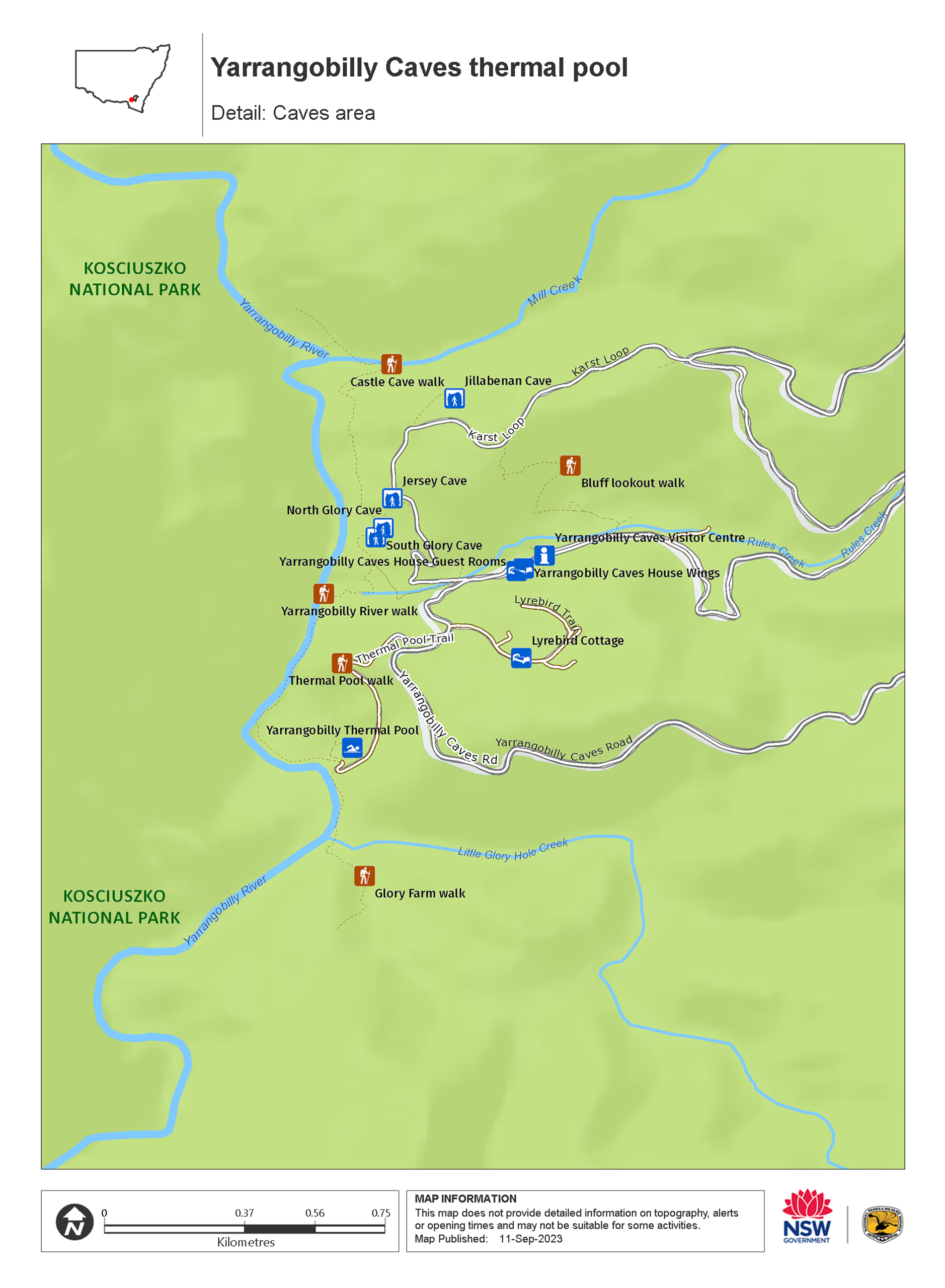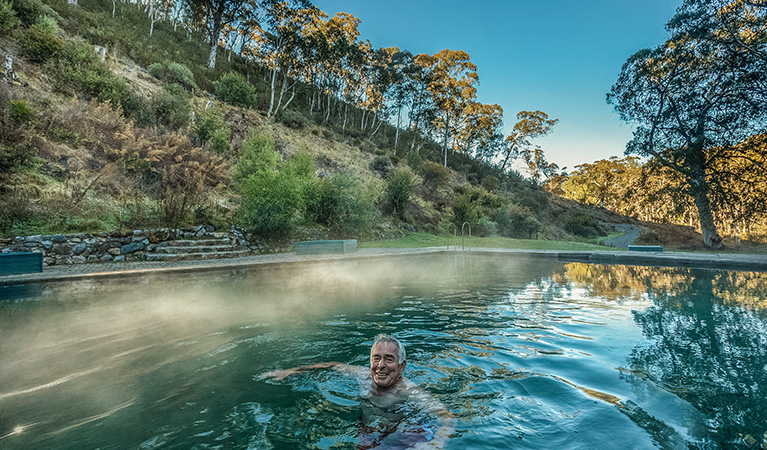Yarrangobilly Caves thermal pool
Yarrangobilly area in Kosciuszko National Park
Overview
Yarrangobilly Caves thermal pool, fed by a natural spring, is a magical swimming spot that’s easily combined with a picnic and walk in the Yarrangobilly area of Kosciuszko National Park.
In a pristine mountain river setting, you probably wouldn’t expect to find a pool, never mind one permanently heated to 27ºC by a natural spring. But that’s exactly what you’ll discover at Yarrangobilly Caves.
The main pool overflows with a gentle cascade into a children’s wading pool.
In summer, come here for a quick swim and a picnic. In winter, it’s magical to float in the warmth and watch steam rise from the water’s surface, as snow blankets the ground around you.
There’s a picnic area next to the pool, as well as change rooms and toilets. Access is via the short but steep thermal pool walk, or along Yarrangobilly River walk loop.
Nearby
-

Yarrangobilly Caves thermal pool walk
Take the short Yarrangobilly Caves thermal pool walk and enjoy a swim in the spring-fed natural pool. It's easily combined with a picnic, bushwalk or cave tour in the Yarrangobilly area of Kosciuszko National Park.
-

Yarrangobilly River walk
Follow the family-friendly Yarrangobilly River walk, at Yarrangobilly Caves, beside the crystal-clear river. Enjoy the views, spot wildlife, and stop for a swim at the Thermal Pool along the way.
-

Glory Farm walk
Glory Farm walk is an easy extension to the thermal pool walk at Yarrangobilly Caves. Follow the Yarrangobilly River to the site of Henry Harris’s Glory Hole Farm.
These maps give a basic overview of park attractions and facilities, and may not be detailed enough for some activities. We recommend that you buy a topographic map before you go exploring.
Map

Map legend

Local alerts
For the latest updates on fires, closures and other alerts in this area, see https://www.nationalparks.nsw.gov.au/things-to-do/swimming-spots/yarrangobilly-caves-thermal-pool/local-alerts
General enquiries
- National Parks Contact Centre
- 7am to 7pm daily
- 1300 072 757 (13000 PARKS) for the cost of a local call within Australia excluding mobiles
- parks.info@environment.nsw.gov.au
Park info
- in the Yarrangobilly area of Kosciuszko National Park in the Snowy Mountains region
The Yarrangobilly area is open all year. See individual show caves and guided tours for times and prices. Additional tours run during NSW school holidays. Contact Yarrangobilly Caves on (02) 6454 9597 to confirm the tour times for your visit.
-
Park entry fees apply in the Yarrangobilly area
$4 per vehicle per day applies at Yarrangobilly Caves for motor vehicles without a Kosciuszko National Park day pass or NPWS All Parks annual pass.
See vehicle entry fees for other areas in Kosciuszko National Park.
You’ll need to buy a ticket or cave pass from the Yarrangobilly Caves Visitor Centre to visit all Yarrangobilly’s caves.
Buy annual pass.
Visitor info
All the practical information you need to know about Yarrangobilly Caves thermal pool.
Maps and downloads
Visitor centre
-
Yarrangobilly Caves Visitor Centre
50 Yarrangobilly Caves Road, Yarrangobilly, NSW 2720 - 9am to 5pm daily. Closed Christmas Day
- 02 6454 9597
Learn more
Yarrangobilly Caves thermal pool is in Yarrangobilly area. Here are just some of the reasons why this park is special:
Unique landscapes

Yarrangobilly’s karst landscapes were created from a belt of limestone laid down about 440 million years ago. Almost all cave formations can be seen here, from stalactites and stalagmites, hollow straws and delicate helictites, to shawls, cave coral, and massive flowstones. Karst environments are nature’s time capsules, preserving evidence of climate change, floods, droughts, fires, animal and human activity. Over the years, Yarrangobilly's caves have hosted researchers from universities, nuclear science organisations and the Snowy Hydro. You can now visit Harrie Wood Cave, which was closed from 2006-2016, to learn how stalagmites have growth rings, and find out about about climate change monitoring.
- Jersey Cave Step back in time on a guided tour of Jersey Cave. You’ll be awed by some of the most colourful and diverse decorations at Yarrangobilly Caves in Kosciuszko National Park.
- Jillabenan Cave Take a fascinating guided tour of Jillabenan Cave. It's the smallest and most accessible of the Yarrangobilly Caves in Kosciuszko National Park, but it's packed with incredibly delicate formations.
- North Glory Cave North Glory Cave tours run on a limited schedule, generally aligned with NSW school holidays and some long weekends. If you’d like to visit this cave, please check tour availability using the ‘Book Now’ button.
- South Glory Cave Take a leisurely self-guided tour through the lofty chambers of South Glory Cave at Yarrangobilly, near Tumut. It never fails to astonish.
Explore above and below ground

No visit to Yarrangobilly is complete without a visit to its marvellous caves, so stop by the Yarrangobilly Caves Visitor Centre to get your tickets and tour times. The largest, South Glory Cave, allows you to explore at your own pace on a self-guided tour. Jersey and Jillabenan Caves offer guided tours that run 3 or 4 times daily - Jillabenan even boasts wheelchair-access. The visitor centre can also help with tours of other caves, meetings, weddings, custom tours for groups or students from 10 to 100 people. With caves, tours, walks, and the natural mineral waters of the thermal pool to tempt you, you’ll need to stay a few days. Book your own lovingly restored wing or a great-value room at Caves House. Enjoy the creature comforts of Lyrebird Cottage, or set up camp at Yarrangobilly Village campground, just off the Snowy Mountains Highway.
- Yarrangobilly Caves thermal pool walk Take the short Yarrangobilly Caves thermal pool walk and enjoy a swim in the spring-fed natural pool. It's easily combined with a picnic, bushwalk or cave tour in the Yarrangobilly area of Kosciuszko National Park.
- Yarrangobilly Caves Visitor Centre Yarrangobilly Caves Visitor Centre is your one stop destination for information on cave tours and tickets, and top tips on where to stay and what to do in the Yarrangobilly and northern areas of Kosciuszko National Park.
A wonderland for wildlife

Karst environments are complex ecosystems containing highly specialised plants, animals and micro-organisms. The dense shrubs around Yarrangobilly River provide protection for the endangered smoky mouse, as well as being great for bird watching. At night you might be lucky to see a possum or sugar glider, forest bats, tawny frogmouth owl or even an endangered sooty owl. Don’t be put off if you see algae or even springtime tadpoles in the thermal pool. Algae and weed provide a breeding site for eastern banjo frogs, aka pobblebonks, because of their banjo-like ‘plonk’ or ‘bonk’, meaning the water is clean and healthy. School students can learn more about Kosciuszko National Park’s ecosystems and important biodiversity on a school excursion.
Discover Aboriginal culture

Yarrangobilly is the perfect place to experience the rich Aboriginal culture of the Wolgalu People. Join a NPWS Aboriginal ranger to see the tools and techniques of the Traditional Owners of this unique landscape. Take part in hands-on activities like string making, or learn how to start a fire without matches. Wolgalu culture tours run on select dates during school holidays, and start from the picnic area near Yarrangobilly Caves Visitor Centre (bookings essential).
Plants and animals protected in this park
Animals
-

Bare-nosed wombat (Vombatus ursinus)
A large, squat marsupial, the Australian bare-nosed wombat is a burrowing mammal found in coastal forests and mountain ranges across NSW and Victoria. The only other remaining species of wombat in NSW, the endangered southern hairy-nosed wombat, was considered extinct until relatively recently.
-

Eastern water dragon (Intellagama lesueurii lesueurii)
The eastern water dragon is a subaquatic lizard found in healthy waterways along eastern NSW, from Nowra to halfway up the Cape York Pensinsula. It’s believed to be one of the oldest of Australian reptiles, remaining virtually unchanged for over 20 million years.
-

Platypus (Ornithorhynchus anatinus)
One of the most fascinating and unusual Australian animals, the duck-billed platypus, along with the echidna, are the only known monotremes, or egg-laying mammals, in existence. The platypus is generally found in permanent river systems and lakes in southern and eastern NSW and east and west of the Great Dividing Range.
-

Superb fairy wren (Malurus cyaneus)
The striking blue and black plumage of the adult male superb fairy wren makes for colourful bird watching across south-eastern Australia. The sociable superb fairy wrens, or blue wrens, are Australian birds living in groups consisting of a dominant male, mouse-brown female ‘jenny wrens’ and several tawny-brown juveniles.
-

Superb lyrebird (Menura novaehollandiae)
With a complex mimicking call and an elaborate courtship dance to match, the superb lyrebird is one of the most spectacular Australian animals. A bird watching must-see, the superb lyrebird can be found in rainforests and wet woodlands across eastern NSW and Victoria.
-

Swamp wallaby (Wallabia bicolor)
The swamp wallaby, also known as the black wallaby or black pademelon, lives in the dense understorey of rainforests, woodlands and dry sclerophyll forest along eastern Australia. This unique Australian macropod has a dark black-grey coat with a distinctive light-coloured cheek stripe.
Plants
-

Billy buttons (Craspedia spp. )
Billy buttons are attractive Australian native plants that are widespread throughout eastern NSW in dry forest, grassland and alpine regions such as Kosciuszko National Park. The golden-yellow globe-shaped flowers are also known as woollyheads. Related to the daisy, billy buttons are an erect herb growing to a height of 50cm.
Environments in this area
General enquiries
- National Parks Contact Centre
- 7am to 7pm daily
- 1300 072 757 (13000 PARKS) for the cost of a local call within Australia excluding mobiles
- parks.info@environment.nsw.gov.au
Operated by
- Yarrangobilly Caves Visitor Centre
- 9am to 5pm daily. Closed Christmas Day
- 02 6454 9597
- yarrangobilly.caves@environment.nsw.gov.au
- 50 Yarrangobilly Caves Road, Yarrangobilly, NSW 2720
Park info
- in the Yarrangobilly area of Kosciuszko National Park in the Snowy Mountains region
The Yarrangobilly area is open all year. See individual show caves and guided tours for times and prices. Additional tours run during NSW school holidays. Contact Yarrangobilly Caves on (02) 6454 9597 to confirm the tour times for your visit.
-
Park entry fees apply in the Yarrangobilly area
$4 per vehicle per day applies at Yarrangobilly Caves for motor vehicles without a Kosciuszko National Park day pass or NPWS All Parks annual pass.
See vehicle entry fees for other areas in Kosciuszko National Park.
You’ll need to buy a ticket or cave pass from the Yarrangobilly Caves Visitor Centre to visit all Yarrangobilly’s caves.
Buy annual pass
What's nearby:
Things to do (46)
- 4WD touring (1)
- Adventure sports (1)
- Birdwatching and wildlife encounters (1)
- Cafes and kiosks (1)
- Cycling (2)
- Fishing (8)
- Historic heritage (5)
- Horse riding (3)
- Picnics and barbecues (4)
- Road trips and car/bus tours (4)
- Show cave tours (6)
- Sightseeing (5)
- Snow sports (3)
- Swimming (6)
- Visitor centres (2)
- Walking (19)
- Waterfalls (3)
- Wildflowers (seasonal) (1)

